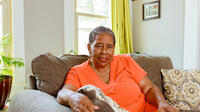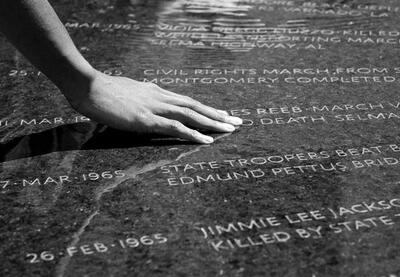Opposition to equality is, unfortunately, not new to the history of the United States. Recognizing the relevance of history to today’s justice and civil rights movements is crucial for understanding and countering current pushbacks against democratic values.
This learning journey offers an overview of the hostile opposition to the Civil Rights Movement and examines the questions: How can honestly confronting the history of opposition to equality help us understand our nation? Can history help us resist hate in today’s society and work toward a more inclusive future?
Analyzing the opposition to the Civil Rights Movement can help us to understand the exceptional strength of the ordinary people who were part of the movement. And recognizing that racism wore both institutional and individual faces can help us to understand the importance of the movement’s achievements and the work that remains.
The Civil Rights Movement of the 1950s and ’60s faced hostile opposition. White supremacists used a range of tactics — from cultural campaigns to legal strategies to terrorist attacks — to try to slow or prevent the movement for equality and justice.
- Faced with a changing country and demands for Black equality, white supremacists across the U.S. continued to use racial terror against Black people and other people of color.
- Across the nation, violence against activists — including police violence — remained commonplace and brutal. It included lynchings, bombings, assassinations and incarceration, extending well beyond the South to urban centers like Oakland, Chicago, and New York City.
- Opposition to the movement came in many forms, including from white elected officials at the federal, state and local levels; local opposition to school integration; pushes for the disenfranchisement of Black voters; the increased popularity of racist philosophies; and the formation of “white citizens’ councils” — local groups designed to maintain white power.
- At the onset of the Cold War in the 1950s, members of the U.S. House of Representatives led anti-communist purges. Noted intellectuals and activists were stigmatized and persecuted for perceived communist sympathies.

“I was 11 years old in 1965 on that bridge. March 7th, 1965, to be exact. That day went down in history as Bloody Sunday. … When it started, I was terrified, horrified to see people laying bleeding. And then the tear gas got me, so I panicked, and we were trying to get back across the bridge.”
— Jo Ann Bland, from “The Strength of Ordinary People”
Research and Learn More
- To better understand the scope of racial terror — and the lack of accountability for its perpetrators — visit the website of the SPLC’s Civil Rights Memorial Center. The pages Civil Rights Martyrs and The Forgotten provide the names, stories and photographs of some of those murdered by white supremacists during this period.
- For insights on the March 7, 1965 Selma to Montgomery march, watch the LFJ video interview with Jo Ann Bland, “The Strength of Ordinary People;” Bland was 11 years old when she participated in the march and witnessed the violence of Bloody Sunday. Learn more about historical background and events of the Selma march, and the violence that followed, with LFJ’s learning journey “Selma: From the Bridge to the Ballot.” The LFJ Text Library includes essays on the murders of Jimmie Lee Jackson, James Reeb and Viola Liuzzo from the 1989 collection Free at Last: A History of the Civil Rights Movement and Those Who Died in the Struggle. And the PBS series Eyes on the Prize episode “Bridge to Freedom (1965)” focuses on the Selma to Montgomery march.
- Freedom Summer workers and volunteers faced hostile opposition from the white community, including several murders and dozens of beatings, bombings and fires. Among those murdered that summer in 1964 were three civil rights workers, whose deaths resulted in intensive media attention—James Chaney, a young Black CORE volunteer, and Michael Schwerner and Andrew Goodman, two Jewish activists from New York, who were murdered on June 21, 1964. In the search for the three activists, eight other murdered Black men were found, including Charles Eddie Moore, a college student, and Henry Hezekiah Dee. These are but a handful of the people, the vast majority Black Americans, who were murdered or experienced violence during Freedom Summer and the momentous decades of the Civil Rights Movement. Watch a video clip summary of the 1964 murders (from Voices of the Civil Rights Movement).
- Learning about some of the most famous martyrs of the movement is important. In addition to Emmett Till, research about the four girls murdered in the 1963 bombing of the 16th Street Baptist Church in Birmingham, Alabama. Read the LFJ text “Addie Mae Collins, Denise McNair, Carole Robertson, & Cynthia Wesley.” Educators can review the lesson plan from Kids in Birmingham 1963 for first-person stories from Birmingham residents who were the same ages as the victims at the time of the bombing.
- The 2010 New York Times article “Race Against Time,” available through LFJ’s text library, can help in understanding both the scale of the violence and the degree to which it went unpunished.
- The 1963 SNCC report “Violence Stalks Voter-Registration Workers in Mississippi” details the various types of reprisal and violence that members of SNCC experienced while registering Black voters in the South, including constant harassment from police, not just from private citizens. The 1964 article “Incident in Hattiesburg,” written by Howard Zinn and published in The Nation, further describes some of the violence faced by SNCC volunteers in Mississippi.
- Read the LFJ text “A Personal Mission: Sammy Younge Jr.” to learn about how the 1963 murder of a young activist led to the election of the South’s first Black sheriff since Reconstruction.
- To learn about White Citizens’ Councils, explore the University of Mississippi’s digital archives, particularly the Citizens’ Council Collection. The 1958 pamphlet “Association of Citizens’ Councils of Mississippi, 4th Annual Report” (available in the LFJ text library) offers a clear example of the activity of these reactionary groups of white Americans committed to reversing federally mandated integration policies.
- Learn about the Lost Cause of the Confederacy mythology and how it became more popular during desegregation. Analyze how the myth was perpetuated by groups like the United Daughters of the Confederacy, which pushed for Confederate-friendly instructional materials in schools and for building monuments that are still debated today. “How Southern Socialites Rewrote Civil War History,” a video from Vox, offers a succinct introduction. To trace the connection between civil rights gains and the increased popularity of Confederate monuments and place names — and to better recognize the way this iconography spread beyond the Deep South — explore the SPLC report Whose Heritage? which catalogs the locations and dates of origin of more than 1,500 public symbols of the Confederacy across the U.S.
- The PBS series Eyes on the Prize offers an accessible introduction to key ideas, figures and moments in civil rights history. To better understand the depth and breadth of white opposition to school integration, you can watch part of the episode “The Keys to the Kingdom,” which covers the period from 1974 to 1980 and highlights violent opposition to school integration in Boston, as well as other key events.
- To understand the scale and many forms of opposition to integration, students can read some or all of the “Massive Resistance” section of the Equal Justice Initiative’s Segregation in America report. The Legal Defense Fund’s article “The Southern Manifesto and ‘Massive Resistance’ to Brown” offers a briefer introduction.
- Students can examine documents about the integration of Little Rock schools to better understand the tension between the federal government and the state government on desegregation. For example, they should know that President Eisenhower issued Executive Order 10730 to assist the Little Rock Nine in attending school. They can compare this order to the September 1958 “Orval Faubus speech,” in which the Arkansas governor explained his preference to shut down high schools rather than integrate. Studying these documents can help students understand the power white elected officials at the state level held when opposing civil rights.
- To understand the limits of Brown v. Board of Education, review some of the many ways Black people had to keep working to dismantle segregation at local, state and national levels. Students can read the 1958 Washington Observer story “Segregation’s Citadel Unbreached in 4 Years” to get a sense of the ways Southern communities resisted desegregation.
- For examples of how charges of communism were used to threaten civil rights leaders or turn public sentiment against them, review Anne Braden’s short publication House Un-American Activities Committee: Bulwark of Segregation. Reading sections or reviewing images in this primary text will help students recognize how the “Red Scare” was used to attack organizations like CORE and the NAACP and individual leaders like Martin Luther King Jr.
- During the Cold War, the House Un-American Activities Committee (HUAC) exercised its power to stigmatize Black civil rights advocates for perceived communist sympathies. To further examine how anti-communist purges intersected with the Civil Rights Movement of the 1950s and 1960s, review the June 12, 1956, Testimony of Paul Robeson before the House Committee on Un-American Activities. You can also analyze the 1953 article “McCarthy: Enemy of the Negro People” (available in the LFJ text library), particularly focusing on the testimony of Eslanda Goode Robeson, and consider how Sen. Joseph McCarthy exposed his position on the movement. Look for examples of the coded language of sexism, which presented further obstacles for Black women involved in the movement.
Resist telling a simple story.
The honest history of the Civil Rights Movement includes the truth of the hostile and violent opposition to the movement. In telling the honest and complicated history, we refuse to sanitize the past. Young people can learn — in age-appropriate and culturally responsive ways — about the realities of racism, systems of racial control, and racial violence that prompted the Black movement for equality and civil rights and persisted beyond the 1960s.
When history diminishes the severity of past obstacles, it also diminishes the work of activists who confronted those obstacles.
Reflection and Action
1. Confronting Racism in Society
- How can honestly confronting the history of opposition to equality help us understand our nation? What parallels exist between events of the early 1960s and events today? Can learning from history help us resist hate in today’s society and work toward a more inclusive future?
- What effect did the civil rights movement have on racial discrimination and injustice? In what ways was it successful? In what ways do racial discrimination and injustice still exist?
- What does it take to end deeply ingrained injustice?
2. Action in Your Community
- Find out about community groups and organizations in your state that are advocating for equality and justice. What are they doing, and what strategies are they using? Are there opportunities for you join in their work?
